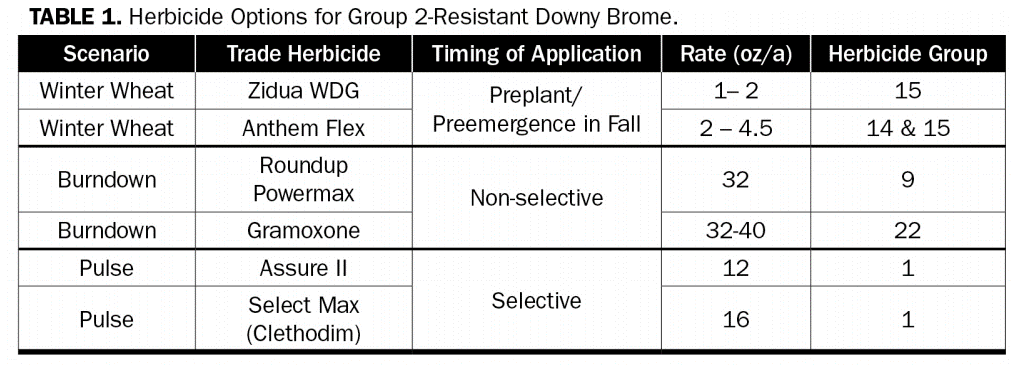
Downy Brome
Herbicide-resistant plants often develop from repeated use of a single mode of action herbicide. Plants can then develop resistance to additional herbicides, and then require integrated, and more costly, management techniques.
Last Updated: 07/18by Tyler Lane, Prashant Jha, Elin Kittelmann, Kari Lewis, Brent Roeder, Jesse Fulbright, and Adriane Good - Montana State University
Downy brome (Bromus tectorum L.), also known as cheatgrass, is a problematic weed in dryland winter wheat and winter wheat-fallow/pulse crop rotations. As of February, 2018, Group 2-resistant downy brome has been identified in Chouteau, Yellowstone and Carter Counties in Montana.
Identifying Downy Brome
Downy brome is identified as a winter annual weed, but may germinate in the spring. Downy brome can produce more than 70 million seeds per acre annually. Seeds usually germinate soon after maturation and dispersal from the plant. In Montana, seed production typically takes place from May to June. The majority of seedlings emerge in the fall, a few in early spring. Seeds can be dispersed long distances by wind, machinery, contaminated hay, and straw. Seeds can remain viable for more than two-three years in the soil.
Herbicide Resistance Cases
In addition to identification in Chouteau, Yellowstone and Carter Counties, more positive identifications may be made as testing continues. Cross-resistance has resulted from repeated use of Group 2 herbicides for weed control in winter wheat. Group 2 herbicides include Beyond, Maverick, Powerflex, or Olympus.
Group 2 - Resistance Testing
Growers who suspect a Group 2-resistant weed population in any crop should contact their local MSU Extension office for instructions on submitting a sample for testing. Testing is offered as a free service through the MSU-Southern Agricultural Research Center Weeds Lab:

FIGURE 1. The confirmed counties with Group-2 resistant downy brome are Carter, Yellowstone, and Chouteau as of 2017.
Integrated Management Techniques
To combat Group 2-resistant downy brome, it is critical that a multi-faceted approach be utilized. Group 2-resistant downy brome developed due to repeated herbicide use and must be addressed with an integrated approach.
Recommendations:
- Diversify crop rotation - Diverse crop rotations use multiple management tactics and herbicides with different modes of action.
- Enhance crop competitiveness by increasing seeding rate and decreasing row spacing.
- Deep-banding Nitrogen fertilizer enhances crop competitiveness, thus suppressing downy brome growth.

FIGURE 2. Downy brome infestation in winter wheat. Photo by Prashant Jha.

Herbicide Use Recommendations
The following are herbicide recommendations for managing group 2-resistant downy brome:
- Apply herbicides at full labeled rates with recommended adjuvants. Repeated exposure to improperly mixed or low herbicide application rates allows survival of resistant individuals and only perpetuates the herbicide-resistance problem.
- Scout fields regularly prior to and following herbicide applications. Promptly destroy any weed escapes prior to flowering.
- Rotate herbicides and tank-mix with different modes of action over multiple growing seasons in all fields. Consecutive applications of herbicide of the same family (indicated by group number) increases the risk of developing herbicide resistance.
- Use best herbicide application techniques. Improperly calibrated sprayers, incorrect nozzles, poor water quality, etc. decrease herbicide effectiveness and can perpetuate resistance.
- Target early fall and early spring control of downy brome with herbicides (Table 1) appropriate to the crop. Apply Zidua (preemeregence) or Anthem Flex (preplant/ preemergence) in winter wheat at the full use rate early in the fall before downy brome seeds germinate to obtain excellent control. Manage a Group-2 resistant downy brome seed bank in rotational pulse crops with burndown herbicides prior to planting, and Assure II or Select in-crop. In most cases, Beyond herbicide (4 fl oz/a) is effective in controlling downy brome in Clearfield™ winter wheat.
For More Information
Cheatgrass: Identification, Biology and Integrated Management. MT200811AG, 2017.

FIGURE 2. A drawing of a downy brome plant, enlarged spikelet and seed.
USDA-NRCS PLANTS Database/Hitchcock, A.S. (rev. A. Chase). 1950. Manual of the grasses of the United States. USDA Miscellaneous Publication No. 200. Washington, DC
This article is for educational purposes only. Mention of a specific product should not be considered as approval, nor should failure to mention a product be considered disapproval. Read the product label before using any herbicide.

